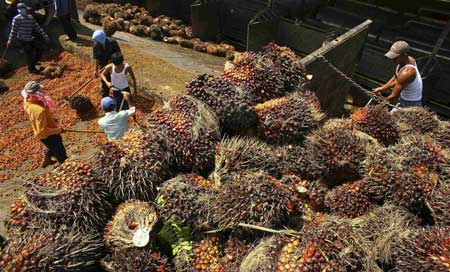|
KUCHING: Latest monthly results in the palm oil sector have come as no surprise to analysts, seeing that the industry is still plagued by weather conditions and seasonal impact.

LESSER LOAD: Workers unload palm fruits at a local palm oil factory. Latest MPOB monthly results have come as no surprise to analysts, seeing that the industry is still plagued by weather conditions and seasonal impact. – Reuters photo
In a statement, overseeing body Malaysian Palm Oil Board (MPOB) reported that the nation’s palm oil stocks declined by 1.52 per cent to 2.068 million tonnes in November this year from 2.1 million tonnes in October.
Additionally, crude palm oil (CPO) stocks in November fell by 3.3 per cent month-on-month (m-o-m) to 1.23 million tonnes, while processed palm oil went up by 1.21 per cent to 841,698 tonnes.
“As expected, production and exports took a dive on monthly basis and as a result, stocks shrank for the second consecutive month. This is conforming to our expectations that the peak production month (October/November) has been diminished by the lag effect of strong El Nino in 2009 as well as the current La Nina cycles,” noted TA Securities Holdings Bhd’s plantations analyst James Ratnam yesterday.
According to MPOB, total November CPO output slipped by 14.76 per cent to 1.626 million tonnes from 1.908 million tonnes in October. Palm oil exports, on the other hand, decreased by 9.94 per cent to 1.66 million tonnes against 1.84 million tonnes in October with palm kernel oil exports slid down by 8.2 per cent to 108,041 tonnes.
“As expected, demand for CPO has weakened as exports to major palm oil consumers such as China, India and Europe plunged by between 18 per cent and 38 per cent m-o-m,” observed analyst Alan Lim from Kenanga Investment Bank Bhd (Kenanga Investment).
Adding further, Lim said although December-2011 production should decline between 10 per cent and 15 per cent m-o-m, there would still be a significant risk to CPO exports due to the economic slowdown in Europe.
In addition, demand for processed palm oil from the country could also be affected by the price advantage enjoyed by Indonesian downstream players.
“In fact, cargo surveyor Intertek has reported a five-per cent drop m-o-m in CPO exports for the first 10 days of December,” Lim noted.
In a similar sentiment, analysts at ECM Libra Capital Sdn Bhd (ECM Libra) noted that inventory levels for November remained flat at 2.1 million metric tonnes, in line with the declines in exports and production levels.
“As production in the coming months is expected to be slower, we expect inventory levels to ease below two million metric tonnes,” they added. However, ECM Libra also noticed that while m-o-m exports to India – the nation’s largest CPO buyer – dropped , year-to-date exports had risen by 40 per cent.
“We attribute this to the wide price discounts between soybean and CPO. Going forward, we expect exports to China to increase as the winter season draws to a close, coupled with the oncoming Chinese New Year festivities in January.”
Notwithstanding this, ECM Libra believed that going into next year, the sector’s production would enter the down-cycle and with the presence of a mild La Nina, production could remain slow going into the first quarter.
“The Australian Bureau of Meteorology’s Southern Oscillation Index (SOI) has strengthened over the past fortnight, by which they expect La Nina to peak next month. With the South American soybean supply has been affected by severe weather conditions, this would tighten soybean supplies; keeping soybean and in turn, CPO prices high.
“We maintain our call for CPO average selling price of RM3,000 per metric tonne for 2012,” it said.
Meanwhile, Kenanga’s Lim said inventory would remain above the 1.69-million metric tonne level as CPO demand would weaken during the winter season in the northern hemisphere as consumers would switch to soybean oil.
“Prolonged uncertainties in Europe may suppress CPO prices below RM3,000 after the first quarter of 2012,” he added.
On the other hand, TA Securities’ Ratnam maintained that despite the recent bearish US Department of Agriculture’s data on soybeans, CPO price should remain firm, underpinned by cyclical downtrend in production and further exacerbated by disruptive weather pattern.
“We retain our 2011 CPO price assumption at RM3,200 per metric tonne against the year-to-date level at RM3,284 per metric tonne,” he said.
| 